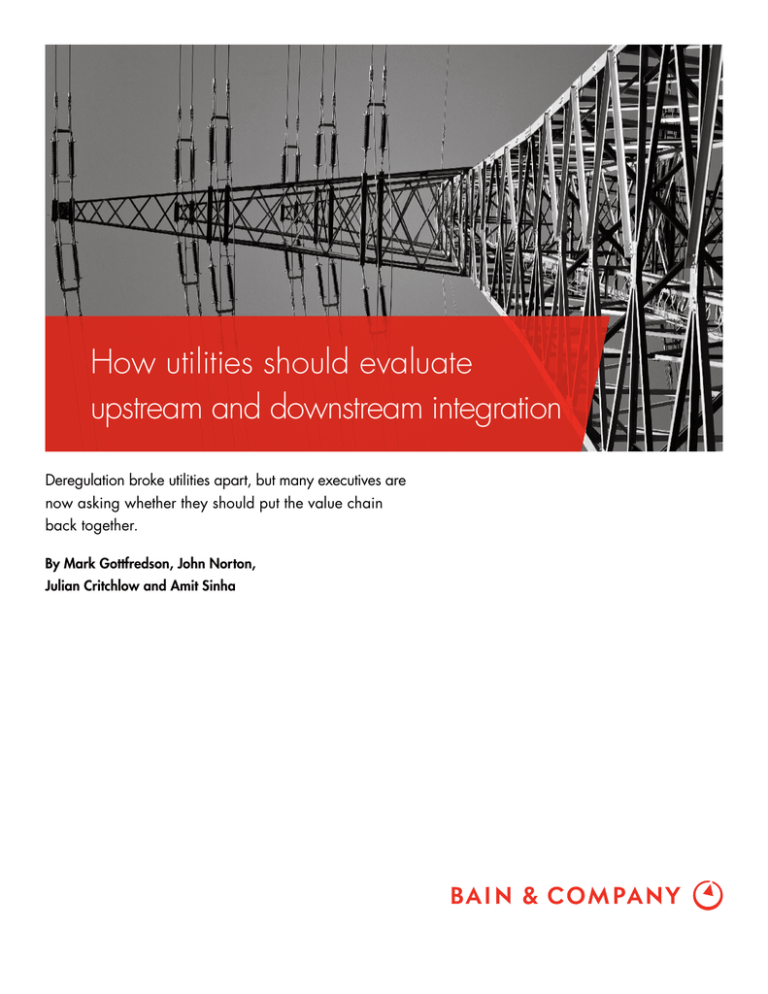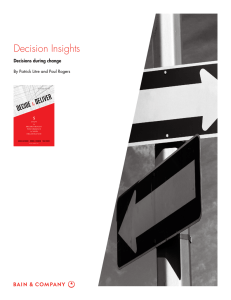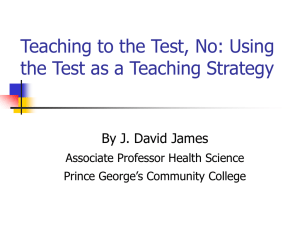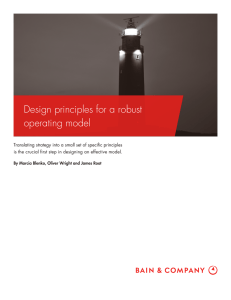
How utilities should evaluate
upstream and downstream integration
Deregulation broke utilities apart, but many executives are
now asking whether they should put the value chain
back together.
By Mark Gottfredson, John Norton,
Julian Critchlow and Amit Sinha
Mark Gottfredson and John Norton are partners with Bain & Company in
Dallas. Julian Critchlow leads Bain’s Global Utilities practice in London.
Amit Sinha is a Bain partner in New Delhi.
The authors would like to acknowledge the contributions of Berthold Hannes,
a partner with Bain & Company in Düsseldorf, and Joseph Scalise, who leads
Bain’s Utilities practice in the Americas in San Francisco.
Copyright © 2013 Bain & Company, Inc. All rights reserved.
How utilities should evaluate upstream and downstream integration
businesses, which demand different capabilities to
succeed. For example, a generator’s costs depend on
fuel supply, capital and depreciation expenses, and the
costs of running power plants. The best way to cut
costs is to improve operational efficiency. A retailer’s
expenses, on the other hand, depend on sourcing costs
for electricity and gas, as well as customer acquisition
and retention. Cost-saving opportunities come more from
building best-in-class trading capabilities, developing sharp
customer insights, raising brand awareness and improving customer relations.
Not long ago, most power utilities were vertically integrated,
with generation, distribution and retail services all under
one business. Then regulators, hoping to unleash the
kind of fluidity and innovation that characterized deregulation in telecommunications, pushed for deregulation
in utilities, separating retail services, distribution and
generation into different organizations.
But for a number of reasons, the energy sector hasn’t
seen the same type of profit-generating innovation.
Telecom innovations increased the use of their services
dramatically. That hasn’t happened in power utilities and,
given efforts to increase energy efficiency, wouldn’t
necessarily be desirable.
Given these differences, what criteria can utility executives
use to evaluate an opportunity to reintegrate, or for an
integrated utility to remain so? The goal must be to
create a company that is better equipped to deal with the
broad trends facing the energy sector, including greater
competition for customers, new investments in renewables and smart grids, stagnating demand due to rising
energy efficiency and distributed generation gaining
market share. In other words, how do you position yourself to win in the new energy world?
Having seen few benefits
from pulling the value chain
apart, many utility executives
are reconsidering putting it
back together again.
Evaluating the benefits of integration
Utility executives around the world are revisiting the
relative advantages of vertical integration, weighing
them against pure plays as retailers or generators. In
addition to the question of how investors value the
business, there are three major potential benefits.
Understanding the value of each can help executives
make the right decision about whether to integrate.
Having seen few benefits from pulling the value chain
apart, many utility executives are reconsidering the
benefits of putting it back together again. Expanding a
business up or down the value chain offers some advantages—a bigger customer base, reduced exposure to
market volatility and access to shifting profit pools. Some
analysts and investors look at these factors and believe
an integrated utility is more valuable than one that isn’t
integrated because it can save transaction costs and hedge
its business against price spikes and cyclical changes
in profitability.
Avoiding transaction costs. This unlocks some value, but
in our experience the scope is limited. For example, a
retail utility considering integrating upstream into
power generation might know more about electricity
prices and avoid paying the bid-ask spread it would
incur on the open market. It would also avoid collateral
costs and have a clearer picture of the relationship
between electricity supply and requirements, improving
its ability to acquire electricity based on demand.
Our analysis shows that while this may be true in
some cases, it often is not. The benefits of vertical
integration are frequently less than executives think,
and focusing on integration can detract from success.
Each case needs to be evaluated on its own merits. Power
generation and retail are, of course, very different
Since the magnitude of these cost savings is fairly limited,
the net present value (NPV) of a typical generation
investment doesn’t change much by adopting a verti1
How utilities should evaluate upstream and downstream integration
Figure 1: Executives must weigh the value vertical
cally integrated model, even when the bid-ask spread
is eliminated completely. Consider the example of a
typical combined-cycle gas turbine (CCGT) plant in
North America. The overall plant NPV is affected more by
energy and capacity payments, with avoided transaction
cost accounting for less than 5% (see Figure 1). On
their own, avoided transaction costs don’t offer enough
incentive to vertically integrate, though they could tip
the scales in a close decision.
integration adds to NPV and the relative costs of
hedging against price spikes
Vertical integration adds only a small contribution to NPV
% of NPV*
100%
23%
4%
80
Integration helps hedge against volatility. Short-term
risks occur when a retailer or generator fails to hedge
against wholesale spot prices rising or falling dramatically. Retailers face short-term increases when demand
spikes, but the issue is also becoming more relevant
for generators, particularly in Europe where supply from
solar and wind generators can spike on sunny or windy
days. These sudden increases can depress prices for
several hours, as happened in France and Germany in
the summer of 2012.
32%
60
40
41%
20
0
Energy
payments
Capacity
payments
Other
Vertical
integration
Note: Ranges based on three regions—PJM (Pennsylvania-New Jersey-Maryland), ERCOT
(Electric Reliability Council of Texas) and NYISO (New York Independent System Operator)
* NPV of a closed-cycle gas turbine plant in the PJM Interconnection system, 2011
Source: Bain & Company
But executives must weigh the costs of integration
against the costs and availability of hedging without
having to own the physical assets. Consider a hot summer
in the southwest US. Would the ability to hedge against
spiking electricity costs be enough to warrant an investment in generation as protection against high wholesale prices? In our analysis of that market, we found
enough liquidity to allow retailers to affordably hedge
without having to invest in generation (see Figure 2).
On the other hand, retailers based in a market with very
low liquidity (that is, where the peak reserve margins
have narrowed significantly and where there is a limited
market for heat rate options) would see a strong argument
for integrating upstream as a means of hedging against
high prices. To make these estimates, utilities will
analyze historic and current loads, taking into account
predictions for future loads.
Figure 2: Hedging decisions come down to the
cost of options vs. the cost of physical ownership
Cost of options can be about one-third of owning
NPV of cost hedging (three-year holding period)
$80M
65
60
45
40
Depreciation
20
Financing
15
Fixed O&M
Option cost
0
Holding options
to purchase
electricity during
peak periods
In India, power generators have moved even further
upstream to ensure their access to fuel. India’s government still controls most coal mining, and some generators have had difficulty securing enough quality coal
for their large power plants (the ultra mega power projects).
To secure a steady supply, some have bought stakes in
coal operations in Indonesia and other countries,
Owning and
operating a peak
capacity plant,*
scenario 1
Owning and
operating a peak
capacity plant,
scenario 2
*Based on option base costs of $6 million and capital costs of about $180 million to build
a 275-megawatt peak capacity plant with 7% financing ($13 million per year) and
operating expenses of $4 million annually over a three-year holding period. Scenario 1
assumes 0% depreciation, scenario 2 assumes 5% depreciation
Source: Bain analysis
2
How utilities should evaluate upstream and downstream integration
following a model developed by Japan’s Coal Development
Organization in the 1980s.
current low natural gas prices would keep wholesale
electricity costs low for the foreseeable future; thus
there was very limited incentive to integrate upstream
to reduce sourcing or transaction costs. Low natural
gas prices are also putting pressure on generators’ margins, further reducing the incentive to move into that
business. For hedging, the utility’s analyses showed that
it was cheaper to use options than to incur the costs of
physical ownership, even in the riskiest markets it
examined. In this particular market, the utility concluded
that upstream integration did not make economic sense.
Successful integration allows a utility to tap different
profit pools. Since boom-and-bust cycles happen at different times along the value chain, integrated utilities
can use the profit available in one segment to fund lean
times in another. For example, higher margins and regulator pressure in the UK’s generation market during
the mid-1990s led to a build-out of more power generation
capacity, mostly CCGT plants. By 2000, excess generating
capacity led to a price war and pressure on generators’
costs, which they had paid during the 1990s, taking
advantage of the decline in wholesale prices to boost
their margins. Integrated utilities were able to benefit
during both periods (see Figure 3).
Downstream integration, on the other hand, may make
more sense in markets where retail is deregulating rapidly.
In Germany, as in other countries, power generation
remains profitable, but there are pressures, including
regulators pushing utilities to generate more power
from renewable sources and to move out of nuclear
power. Rising energy efficiency is also likely to add
pressure as power consumption stagnates, even as power
generation continues to expand. RWE, the country’s
largest generator, holds 25% of the market share for
When does integration make sense?
One North American retail utility considered these three
axes in evaluating whether to move upstream into
power generation. Regarding costs, it found that the
Figure 3: In the UK, higher margins for retailers in the early 2000s followed higher generator margins
in the 1990s. Integrated providers could benefit during both periods.
…follows the logic of the cycle
Shift of margins between production and sales…
Retail prices in UK households
(Real prices 2005, in £/MWh)
Low margins in sales due
to a high production margin
UK
2009
UK
1992
High margins in sales
and a low production margin
UK
2011
£125
Sales
margin
100
UK
2007
Sales taxes,
network
and other
75
50
25
0
1990
UK
1998
UK
2002
Production
1995
2000
2005
2010
Wholesale price (normalized)
Note: The illustrated costs of production are higher than the spot prices
Sources: IEA (2005); PSIRU; Ofgem; DTI; Bain analysis
3
Retail price (normalized)
How utilities should evaluate upstream and downstream integration
electricity generation but only 10% of the retail business. Its main competitors, E.ON and EnBW, have a
more balanced portfolio of generation and retail.
As they approach the question of integration, executives
can take these three steps.
•
First, fix the basics that make a successful business.
Executives in power generation should maintain a
relentless drumbeat on operational excellence.
(See Bain Brief, “Using employee segmentation
to bring out the best in your workforce” for more
on improving performance.) In retail, customer
loyalty is becoming a top priority as consumers
gain more options and greater flexibility. (See Bain
Brief “Turning on customer loyalty” for more on how
to improve customer relationships.) Ensuring you
are executing well in the parts of the value chain
where you currently participate is the critical first
step. Vertical integration will never be an elixir for
poor performance in the base business.
•
Second, understand the relative benefits you can
achieve by vertically integrating through reduced
transaction costs, less market exposure and the
ability to out-invest the competition by tapping into
new profit pools.
•
Third, understand the regulatory environment
that you are playing in and modify the strategy to
take that into account.
The counter argument to vertical integration is that
pure plays—utilities that focus on one part of the value
chain—outperform their diversified peers. Because the
businesses are so different, the capabilities to excel in
each are different—for example, great customer experience
and innovation in retail, vs. reducing operating costs
and ensuring supply in power generation. Executives
need to have a clear understanding of whether particular
company’s expertise limits them to a certain segment.
Where to focus first
Deciding whether, when and how to integrate is part
of the development of a long-term strategy for any utility.
Any forward-looking plan should include strategic
options that give the utility flexibility to change its path
when executives see signposts—events and trends that
signal significant changes. For example, a shift in natural gas prices or export controls would be a signpost
for US utilities and other businesses. (See Bain Brief
“Utilities: The road ahead” for more on long-term strategy.)
4
Shared Ambition, True Results
Bain & Company is the management consulting firm that the world’s business leaders come
to when they want results.
Bain advises clients on strategy, operations, technology, organization, private equity and mergers and acquisitions.
We develop practical, customized insights that clients act on and transfer skills that make change stick. Founded
in 1973, Bain has 48 offices in 31 countries, and our deep expertise and client roster cross every industry and
economic sector. Our clients have outperformed the stock market 4 to 1.
What sets us apart
We believe a consulting firm should be more than an adviser. So we put ourselves in our clients’ shoes, selling
outcomes, not projects. We align our incentives with our clients’ by linking our fees to their results and collaborate
to unlock the full potential of their business. Our Results Delivery® process builds our clients’ capabilities, and
our True North values mean we do the right thing for our clients, people and communities—always.
Key contacts in Bain’s Utilities practice:
Europe: Julian Critchlow in London (julian.critchlow@bain.com)
Berthold Hannes in Düsseldorf (berthold.hannes@bain.com)
Magnus Hoglund in Helsinki (magnus.hoglund@bain.com)
Arnaud Leroi in Paris (arnaud.leroi@bain.com)
Jochem Moerkerken in Amsterdam (jochem.moerkerken@bain.com)
Roberto Prioreschi in Rome (roberto.prioreschi@bain.com)
Jose Ignacio Rios in Madrid (nacho.rios@bain.com)
Philip Skold in Stockholm (philip.skold@bain.com)
Americas: Mark Gottfredson in Dallas (mark.gottfredson@bain.com)
John Norton in Dallas (john.norton@bain.com)
Matt Abbott in Los Angeles (matt.abbott@bain.com)
Neil Cherry in San Francisco (neil.cherry@bain.com)
Paul Cichocki in Boston (paul.cichocki@bain.com)
Miles Cook in Atlanta (miles.cook@bain.com)
Stuart Levy in Washington, DC (stuart.levy@bain.com)
Alfredo Pinto in São Paulo (alfredo.pinto@bain.com)
Tina Radabaugh in Los Angeles (tina.radabaugh@bain.com)
Joseph Scalise in San Francisco (joseph.scalise@bain.com)
Bruce Stephenson in Chicago (bruce.stephenson@bain.com)
Asia-Pacific: Amit Sinha in New Delhi (amit.sinha@bain.com)
Sharad Apte in Bangkok (sharad.apte@bain.com)
Robert Radley in Sydney (robert.radley@bain.com)
For additional information, visit www.bain.com









